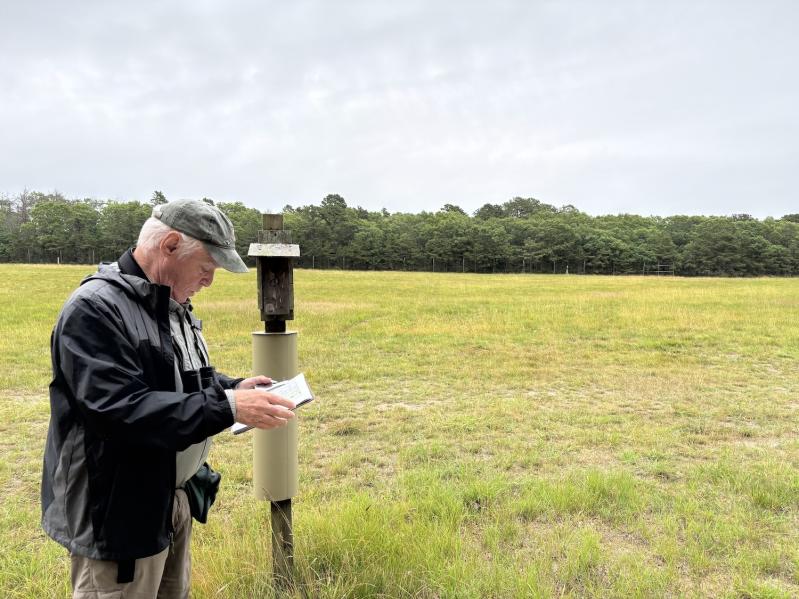“I think this is the most concentrated spot for bluebirds in all of New York State,” says Joe Giunta on a drizzly Saturday morning as he walks along a segment of a bluebird trail on Daniel’s Hole Road, adjacent to 600 acres of relatively open space.
He’s been monitoring this trail and 11 others in the Town of East Hampton for over two decades.
“I think they know me,” he says as a bird eyes him from a low-hanging branch.
There are 45 boxes here and 18 are occupied by the Eastern bluebird. The rest are taken by tree swallows. One box is home to a pair of house wrens. In the past, titmice, black-capped chickadees, and even great-crested flycatchers have nested in the boxes. During the winters, sometimes they are used by woodpeckers.
It will take Mr. Giunta roughly three hours to check all the boxes.
According to Robyn Bailey, Nestwatch project leader for the Cornell Lab of Ornithology, proving it’s the highest concentration of nesting bluebirds in the state would be difficult. Nonetheless, she said, referencing population trend data from eBird, Eastern bluebirds are doing well in the Town of East Hampton.
Mr. Giunta expects nearly 100 bluebirds to fledge from these boxes this year, five times the number that fledged just 15 years ago. It could be a record year. In the last 20 years, close to 2,000 have fledged from the town trails.
Minus a tarmac or two, this swath that includes the East Hampton Town Airport is pristine grassland, a rarity on Long Island. When asked what makes the bluebirds so successful here, Mr. Giunta, a retired high school math teacher, answered in a very matter-of-fact way.
“No people. No dogs. No cats. No herbicides. No pesticides. It’s mowed maybe once a year. It’s a perfect habitat and undisturbed.” Grassy meadows with nearby trees is what they like.

He maintains meticulous reports. In one hand he carries a clipboard that holds a color-coded spreadsheet. Each bird box is numbered and after each visit, he notes its progress and inhabitants. In his other hand, he holds a spackle knife.
“Last I checked this had tree swallow young,” he says, approaching one box.
The box is full of grass woven into the shape of a cup. On top of the cup, white feathers. One drifts out. He explains that the nests are almost always started by bluebirds, but some, after some jousting, are finished by tree swallows. The feathers point to their presence.
No worries there. Tree swallows, insectivores, are in steep decline and need all the help they can get.
Mr. Giunta pushes down the front lip of the cup.
“There’s all fecal matter here. No dead young. So, this was a success. We’ll clean this one out.”
With his spackle knife, he unceremoniously scrapes the nest from the sides of the box. It comes out whole. He tosses it to the ground.
“They’re finished here. The young are gone, and they don’t make a second nest. These tree swallows could be on their way back to Central America already.”
Unlike the “one and done” tree swallow, bluebirds produce two broods each year. The first is typically five eggs; the second is four.
The Eastern bluebird is New York’s state bird, a distinction it won in 1970, after its population had declined by 92 percent in prior decades. Once as common as our more familiar thrush, the American robin, two non-native birds, the house sparrow and European starling, had outcompeted the bluebird for nesting locations, and were largely responsible for the decline.
The Eastern bluebird is smaller than a robin but larger than a sparrow. The azure on its back, wings, and head is unique to the bird world, though sometimes, on the best days, you see the same shade in the sky.
The state distinction helped raise awareness of bluebirds, and nest boxes, a key component of their rebound, started springing up. Many are designed with entrance holes that are too small for starlings. While house sparrows can still be a problem, they’re not an issue at the Daniel’s Hole trail, where flying squirrels were the main threat.
Mr. Giunta once opened a box and found one crammed inside.
It was as surprised to see him as he was to see it. “They eat everything,” he said. “Birds, nestlings, eggs. They’re very destructive.” Their presence forced him to move each of the boxes at least 35 feet from the tree line. Problem solved. The boxes are also installed with raccoon and snake guards, thanks to contributions from the South Fork Natural History Museum.
We watch as a male and female bluebird fly from the tree line to a box, softly chirping while taking turns peering over its ledge into the hole. It’s almost like they’re in conversation.
Inside, four pale blue eggs.
In about two weeks, after some full-time egg sitting by the mother, new bluebirds will emerge from the eggs.
“Eighteen pairs of bluebirds,” says Mr. Giunta, beaming. “Who has that? Nobody has that!”

